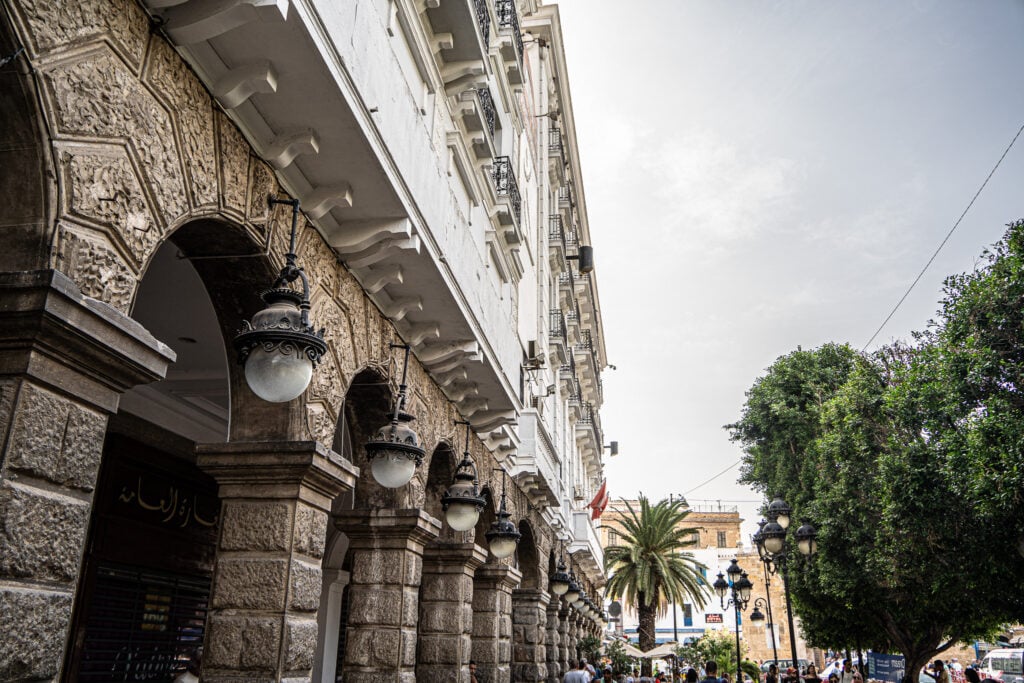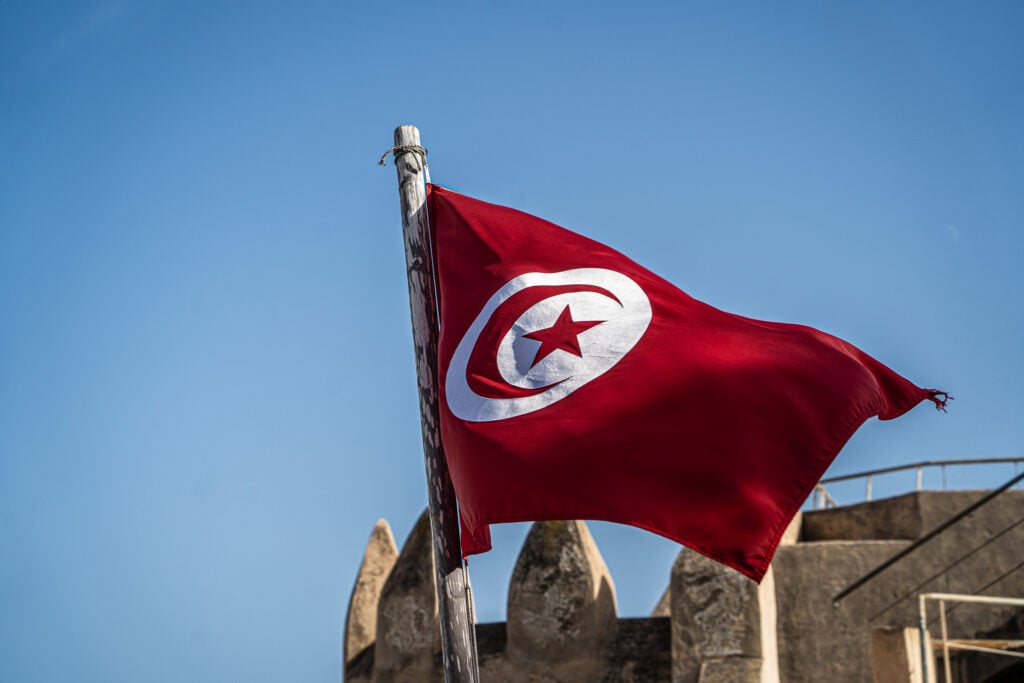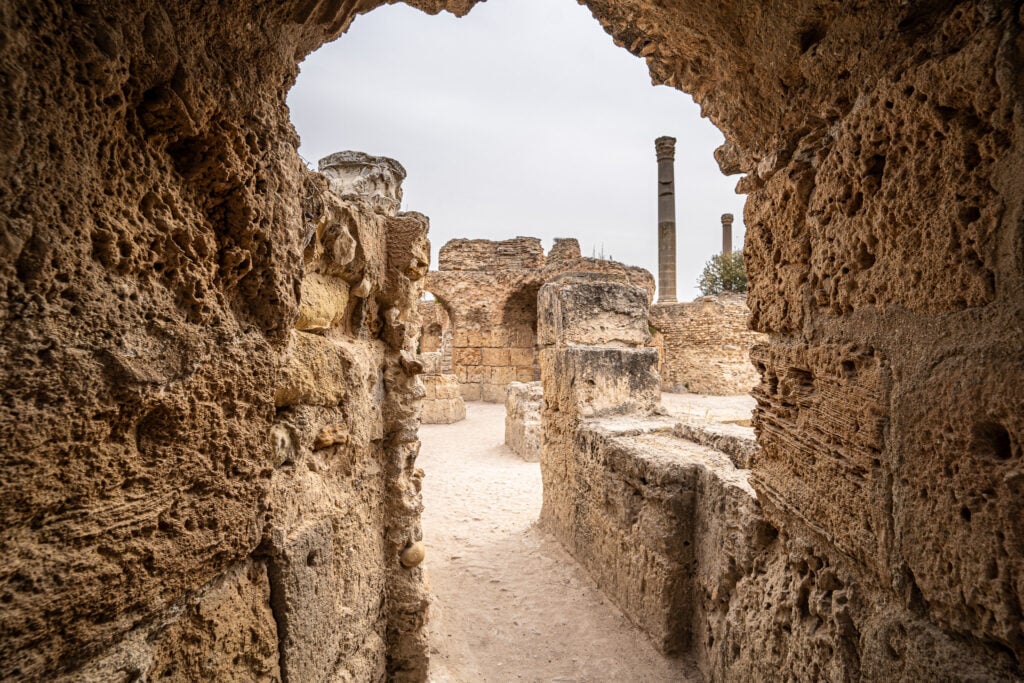Lose your way in the Medina of Tunis, discover the ancient ruins of Carthage and dig into street food; here are the best things to do in Tunis.
Whether you’re navigating the labyrinthine corridors of the historic Medina, soaking up history in the Bardo National Museum, or savouring traditional Tunisian dishes from a street vendor (try the Brik!), Tunis is a city that never fails to excite even the most ardent of world travellers.
With a history stretching back thousands of years, the Tunisian capital is a fascinating blend of Phoenician, Roman, Arab, Ottoman and French influences. Originally a Phoenician settlement, it became part of the Carthaginian Empire, which was conquered by Rome in 146 BCE. As Rome’s influence waned, the region saw invasions from various tribes like the Vandals, eventually becoming part of the Islamic caliphate following the Arab conquest in the 7th century. Tunis rose to prominence as an Islamic centre of learning, particularly during the Aghlabid and later Hafsid dynasties, which left a rich architectural legacy, including the Zitouna Mosque
The late 16th century saw Ottoman rule, followed by a French protectorate in 1881. The city expanded during the French period, with the construction of the Ville Nouvelle, featuring European-style avenues and institutions. Tunis played a pivotal role in Tunisia’s fight for independence, which was achieved in 1956. Today, no trip to Tunisia is complete without a tour of the nation’s capital, so with that in mind, here are the best things to do in Tunis.
Table of Contents
The best things to do in Tunis
From the ruins of Carthage to the bustling shops along Avenue Habib Bourguiba, the Tunisian capital is a city where ancient heritage meets with French colonial influences and Islamic sensibilities. I’ve visited the city twice now, and both times I’ve found myself happily lost for hours in the Medina of Tunis, and I’ll be content to return time and time again to Carthage – they truly are extraordinary ruins.
I’d recommend spending a few days in Tunis, at the very least. Many tourists just visit on a day trip from the coastal resorts in Hammamet or Sousse, but there are some seriously historic boutique hotels in the Medina of Tunis that make for a great base. After seeing the sights in Tunis itself (see below for inspiration!) you’ll also be perfectly placed for day trips to Carthage, Sidi Bou Said and La Marsa.
Read more: How Many Countries Are in Africa? Everything You Need to Know.
1. Lose yourself in the Medina of Tunis
The Medina of Tunis is a sprawling labyrinth of narrow alleys, historic structures and busy souks. Serving as the historical and cultural heart of the city, the Medina was established during the early Islamic period in the 7th century, and it remains an active, living area where trade, tourism, religion and daily life intermingle.
A maze of markets and shops offers everything from spices and textiles to football shirts and wedding dresses. Notable landmarks include the Zitouna Mosque, which has been a centre of Islamic scholarship for centuries, and the Dar Hussein Palace, now serving as the National Institute of Archaeology and Art.
The architecture within the Medina showcases intricate Islamic design, with buildings featuring ornate tilework, carved wooden doors and arched passageways. But it’s not just about the past; the Medina also hosts contemporary boutiques and art galleries, making it a locus for modern Tunisian creativity. As one of Tunisia’s nine UNESCO World Heritage Sites, the Medina encapsulates the layered history of Tunis, offering a vivid representation of the city’s rich past while still very much being a part of its present.

2. Marvel at the Zitouna Mosque
The Zitouna Mosque is a cornerstone of religious and educational life in Tunis. Situated in the heart of the Medina, it dates back to the 8th century. It’s the oldest mosque in the capital and a foundational institution for Islamic scholarship in Tunisia.
Characterised by its imposing minaret and intricate tile work, Zitouna serves as a focal point around which the labyrinthine streets of the Medina are organised. While the prayer hall is accessible only to Muslims, visitors can explore the courtyard and take in the grand architecture. The mosque is not merely a place of worship; it’s also a symbol of Tunis’s deep-rooted Islamic heritage.

Read more: 13 Things to Do in Sousse, Tunisia
3. Explore Tunis New Town
Tunis New Town, also known in French as Ville Nouvelle, serves as the modern counterpoint to the city’s historic Medina. Established during the French colonial period, this area reflects a more European urban planning style, with orderly grid-like streets, wide boulevards and modern infrastructure.
Anchored by Avenue Habib Bourguiba, the New Town is a hub for commerce, entertainment, and governmental activities. A walk through this district reveals a series of contrasts: French colonial architecture sits alongside modern high-rises, while upscale shops and international franchises coexist with local businesses.
The area is home to numerous cultural institutions, including art galleries, theatres, and museums, which contribute to Tunis’s reputation as a city of diverse cultural offerings. The New Town also boasts several green spaces, such as Belvedere Park, providing residents and visitors alike with a respite from the urban hustle.

Read more: 14 Things to Do in Hammamet, Tunisia
4. Stroll down Avenue Habib Bourguiba
Avenue Habib Bourguiba serves as the central artery of Tunis, a space where history, politics, and daily life converge. Named after the first President of Tunisia, locals always compare the avenue to the Champs-Élysées in Paris due to its leafy expanses and significant landmarks, such as the Cathedral of St. Vincent de Paul.
It is a focal point for political gatherings, protests and celebrations alike. At the same time, it functions as a pedestrian thoroughfare where locals frequent cafes and peruse newsstands. Modern and historic architecture coexist along this dynamic avenue, reflecting the multicultural identity of Tunis.
Read more: Where is Tunisia? Everything You Need to Know.
5. Visit the Cathedral of St. Vincent de Paul
The Cathedral of St. Vincent de Paul stands as an architectural testament to Tunis’s diverse religious and colonial history. Situated on Avenue Habib Bourguiba in the Ville Nouvelle, this Roman Catholic cathedral was constructed in 1897 during the French colonial period.
The building incorporates a mix of styles, featuring Gothic and Moorish elements, and its dual towers are a distinguishing feature in the city’s skyline. Inside, you’ll encounter intricate woodwork, stained glass windows, and a serene atmosphere that contrasts with the lively streets outside. Though it may seem out of context in a predominantly Muslim country, the cathedral reflects the multi-layered cultural history that defines Tunis.

6. Walk through the Bab el Bhar
Bab El Bhar, also known as the ‘Sea Gate’, serves as a symbolic gateway between the Medina and the Ville Nouvelle in Tunis. Originally constructed in the 19th century, the archway demarcates the point where the ancient city once met the sea, and where it now meets its modern counterpart.
As you pass through, you transition from narrow, winding streets filled with historical sites to wide avenues lined with contemporary buildings. It’s a place where vendors sell an array of goods, from traditional handicrafts to modern trinkets.

7. Dig into Tunisian history at the Bardo National Museum
The Bardo National Museum is one of the best places to visit in Tunis. Reopened in September 2023 after a large refurbishment, this is one of North Africa’s most important cultural institutions, housing an extensive collection of artefacts that span Tunisia’s long and varied history.
Located in a 13th-century palace, the museum is especially renowned for its Roman mosaics, which are among the finest in the world. These intricate pieces are not just decorative but also offer valuable insights into daily life and mythology of the Roman era.
Alongside these, the museum showcases Islamic art, Punic relics, and more recent historical artefacts. A visit to the Bardo provides a comprehensive overview of Tunisia’s past, making it essential for anyone interested in the region’s history.
Read more: 14 Best Historic Sites in Tunisia
8. Escape the city in Belvedere Park
Belvedere Park offers a serene escape in the heart of Tunis, providing a contrast to the city’s bustling streets. As the largest urban park in the city, it serves as a communal lung, filled with verdant greenery and shaded walking paths.
Elevated above Tunis, the park offers panoramic views that can be enjoyed from its many vantage points. The park is equipped with facilities such as a small zoo, a children’s play area, and a lake where visitors can rent rowboats. For fitness enthusiasts, jogging tracks and exercise areas are also available.
Read more: How Many Countries in North Africa? Everything You Need to Know.
9. See the site of the 2010 Revolution at the Place de la Kasbah
Place de la Kasbah is a significant square located in the heart of Tunis, often associated with political and social activities. It’s situated within the fortified compound of the Kasbah, which houses key government buildings, including the Town Hall.
The square has been a historical centre for power and governance dating back to the Ottoman era. In recent times, it gained renewed importance as a site for political protests, particularly during the Tunisian Revolution of 2010-2011. A blend of historic architecture and modern utility, the Place de la Kasbah serves as both a symbol and a stage for Tunisia’s evolving narrative.

10. Catch a performance at Theatre Municipal de Tunis
The Theatre Municipal de Tunis, located near Avenue Habib Bourguiba, is an iconic establishment in the city’s cultural landscape. Constructed in 1902 during the French colonial period, the theatre boasts an elegant art nouveau facade that stands out among the surrounding buildings.
The interior matches the exterior’s grandeur, adorned with plush red seating and ornate detailing. As a premier venue for performing arts in Tunis, the theatre offers a diverse repertoire, including opera, ballet, and traditional Tunisian performances. Its historical significance and ongoing role in fostering arts make it a focal point for both locals and visitors interested in Tunisian culture; you can purchase tickets on the website.
11. Try the street food
Experiencing street food in Tunis is an essential part of soaking up local culture, and among the dishes that stand out is Makloub. A satisfying, often hearty dish, Makloub is made from flatbread filled with grilled meats, typically chicken or beef, and fresh vegetables such as onions and tomatoes. What sets it apart is the liberal use of Tunisian spices and harissa, a spicy chilli pepper paste, lending the dish a distinct flavour profile.
Brik is another street food staple, a deep-fried pastry with a thin, crispy shell made from a paper-thin dough. The fillings often include a whole egg, tuna, capers and parsley. When bitten into, the yolk oozes out, complementing the salty tuna and crispy exterior.
Lastly, Lablabi is a humble yet flavourful chickpea soup, often eaten for breakfast. It’s typically garnished with stale bread, olives, and boiled eggs, then seasoned with cumin and harissa for that extra kick. Though simple, the mix of textures and flavours makes Lablabi a comforting, filling dish.

12. Stay in a historic hotel in Tunis
Choosing to stay in a historic hotel in Tunis allows you a unique opportunity to delve deeper into the city’s rich history. I stayed at Dar Ben Gacem, for example, which is situated in the ancient Medina. A meticulously restored 17th-century residence, the hotel retains its original architectural features, such as traditional tiles and detailed stuccowork. Each room is thoughtfully designed to evoke different eras of Tunisian heritage, offering guests an immersive experience.
In contrast, Hotel Royal Victoria provides a glimpse into the colonial era. Originally constructed as a British hospital, the building has been converted into a hotel that fuses Victorian architecture with Tunisian touches. It’s located in the Ville Nouvelle, making it an excellent base for exploring both the modern and historic parts of the city. What makes Royal Victoria special is its grand halls and lobbies, adorned with period-specific fixtures, creating an atmosphere reminiscent of a bygone age.

13. Explore the ancient ruins of Carthage
A day trip to Carthage is a journey into ancient history, and it’s easily accessible given its proximity to the capital. The archaeological site is a complex of Roman and Phoenician ruins that provide a tangible link to the Mediterranean’s ancient civilizations.
The key attractions include the Antonine Baths, one of the largest Roman bath complexes in North Africa, and the Byrsa Hill, offering panoramic views of the surrounding area. The Carthage Museum (soon set to reopen in full after a two-year closure) adds context to the ruins, housing an array of artefacts that provide deeper insights into the lives of the Carthaginians and Romans.

14. Visit the beaches of La Marsa
La Marsa is a coastal suburb located just north of Tunis, offering a more laid-back atmosphere compared to the capital’s energetic pulse. Known for its beaches, La Marsa attracts both locals and tourists looking for a respite from the hustle and bustle.
The Corniche, a seafront promenade, is a popular spot for evening strolls, and the nearby cafes provide ample opportunity to relax and watch the world go by. While primarily residential, La Marsa is also sprinkled with upmarket shops and restaurants serving an array of international and Tunisian cuisine. With its blend of leisure and luxury, La Marsa is a favoured destination for those seeking both relaxation and refinement.
Read more: 18 Best Places to Visit in Tunisia
15. See Sidi Bou Said, the Santorini of Tunisia
Taking a day trip to Sidi Bou Said from Tunis is like stepping into a Mediterranean painting. Just a short train ride from the capital, this coastal village is instantly recognisable by its blue-and-white colour scheme. Once the retreat of artists and intellectuals, Sidi Bou Said still maintains an air of bohemian tranquillity.
Cafes such as the famous Café des Delices offer the chance to sip traditional Tunisian tea while enjoying panoramic views of the Mediterranean Sea. Meandering through its cobbled streets reveals not only the Andalusian-influenced architecture but also small galleries and artisan shops. It’s an ideal location for relaxation, reflection, and a slow pace of life away from the capital.

Read more: Tunisia: How to Travel from Tunis to Sousse
Map of the best things to do in Tunis
Here’s a map of the best things to do in Tunis:
FAQ: Things to do in Tunis
Here’s an FAQ on the best things to do in Tunis:
Q1: What are some must-visit historical sites in Tunis?
The Medina and Zitouna Mosque are excellent places to soak in the city’s history. Don’t miss the Roman ruins at Carthage, which are easily accessible for a day trip.
Q2: Are there any noteworthy museums?
The Bardo National Museum stands out for its extensive collection of Roman mosaics and Punic artefacts. The Carthage Museum is another good option, especially if you’re visiting the archaeological sites nearby.
Q3: Where can I enjoy local cuisine?
Street food like Makloub, Brik, and Lablabi are a must-try. These can be found throughout the city, especially in markets and roadside stalls within the Medina.
Q4: Is there an arts and theatre scene?
Absolutely, the Tunis Municipal Theatre is a fine place to catch live performances. Many modern galleries and exhibition spaces can be found in the Ville Nouvelle.
Q5: Can I enjoy nature within the city?
Belvedere Park offers an expansive green space right within Tunis, perfect for a walk or a picnic. La Marsa, although a suburb, offers beautiful beaches.
Q6: What about shopping?
The souks in the Medina are great for traditional crafts and spices. For more contemporary shopping, Avenue Habib Bourguiba and the Ville Nouvelle offer various shops and international brands.
Q7: Any recommended coastal towns for a day trip?
Sidi Bou Said is famous for its blue-and-white architecture and offers spectacular views of the Mediterranean. La Marsa is another coastal suburb where you can relax on the beach.
Q8: Are there any architectural landmarks?
The Cathedral of St. Vincent de Paul offers a fusion of Gothic and Moorish architecture, while Bab El Bhar serves as a symbolic gateway between the old and new parts of the city.
Q9: Where can I experience local culture?
Plenty of local culture can be absorbed by simply walking through the Medina, visiting Place de la Kasbah, or spending an evening at the cafes in Sidi Bou Said.
Q10: Is Tunis family-friendly?
Yes, places like Belvedere Park are perfect for families. The beaches at La Marsa also offer a relaxed setting suitable for children.
There you are! The best things to do in Tunis. What would you add to the list?



Recent Comments